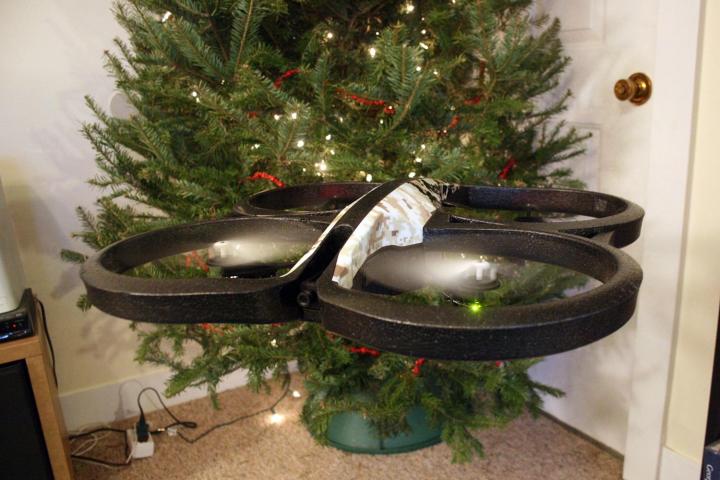
One of my missions here at Digital Trends is to crack through the noise and ruckus of the debate around drones, these unmanned aerial vehicles that are set to take over the world starting in 2015. While I see these negative aspects of UAVs as much as the next guy, I also see their wide-reaching potential to change the world, which is broader than most of us can even imagine.
The first drone I ever laid hands on invaded someone’s privacy – my own.
Too bad the first drone I ever laid hands on invaded someone’s privacy – my own.
You may have heard of the Parrot AR.Drone; it’s the most mainstream UAV on the market – as in, you can buy it at the Verizon store while picking up a new iPhone case. So, to kick off Digital Trends’ drone coverage, I had to get my hands on the latest and greatest version, the Parrot AR.Drone 2.0 Elite Edition.
Unlike many small UAVs and other classic remote-controlled contraptions, the AR.Drone is controlled entirely through a mobile app. Dubbed FreeFlight, the app allows you to not only pilot your drone using your iOS or Android tablet or smartphone, but also to record videos to your handset and upload them to YouTube while the thing zips around your house or backyard.
When I first fired up the AR.Drone 2.0 Parrot graciously sent to my house, I went through all the regular set-up steps any other user would do: I charged the battery, downloaded FreeFlight for my iPhone, and got downright giddy about this 21st century toy. Upon launching FreeFlight for the first time, you’re asked if you want to input your YouTube, Facebook, and Twitter login credentials. Seeing as I needed to put this puppy through the paces – but also not wanting to bombard my friends and followers with random posts – I opted to input my YouTube (i.e. Google) login only.
The day I received the AR.Drone, Mother Nature made herself known with an 9-inch blanket of snow. So, rather than head outside, I impatiently decided to kick off my drone flying career in my living room. The AR.Drone took off, sending my cabal of cats scurrying for the nearest exit. My dog barked manically as this mechanical creature took over our house. Amidst the chaos of takeoff, I noticed a blinking red light next to the “Rec” icon on the FreeFlight control window. Was this thing recording without me telling it to?

The answer, I discovered a few days later, was yes. Not only did the FreeFlight app automatically set the device to capture video from its 720p HD camera, but it also uploaded whatever it recorded directly to my connected YouTube channel. A moment I thought was private – a moment that took place in the privacy of my own home – was, without my knowledge, available for the entire world to see. And I had no idea.
In other words, my drone spied on me.
This essentially confirms the ultimate fear about drones. In addition to conjuring visions of military death machines and police-state surveillance, the thought of a world saturated with drones elicits one thing for many people: peeping Toms trying to sneak a glimpse of something salacious.
My AR.Drone caught nothing of the sort – me, in my living room, trying to figure out the controls without offing one of my terrified cats or barking dog. It did, however, catch my fiancée cleaning the kitchen in her sweatpants then shared that unglamorous moment with Planet Earth. I’m not sure that is any better.
Days went by before I realized that the AR.Drone had sullied the sacred privacy of my home, when I received an email from YouTube alerting me to the fact that someone had commented on the video. Immediately after, I scavenged through the FreeFlight app, trying to discover how this had happened. Turns out, auto-record and auto-upload are turned on by default. (You can switch them off in the “preferences” menu, which I did.)
Despite my experience with the AR.Drone, I remain blissfully optimistic about these flying robots.
This may seem like an isolated matter, something the Parrot people simply need to sort out. But it’s more than that – it speaks to the very issue everyone worries about with drones, the Internet, and the increasingly connected world in which we live: That somehow, sometime, this whole thing is going to get out of control, and we won’t even know that it’s happening.
Despite my experience with the AR.Drone, I remain blissfully optimistic about these flying robots. They are both fun, and hold immense potential. They are also loud, slightly unwieldy, and take a good deal of skill to fly with any precision – so worrying about people using them to spy in your bedroom window is unnecessary … at least for now.
What I did learn is, as drones increasingly make their way into everyday life, we all need to have a better grasp on what this technology is capable of doing. Because, if not, we’ll all end up on YouTube, in sweatpants, ignorant of the consequences.


